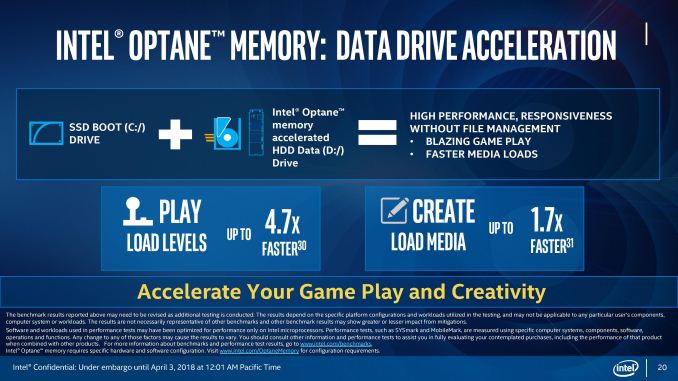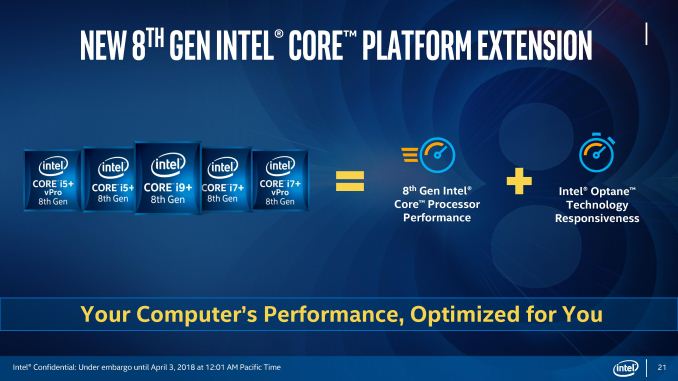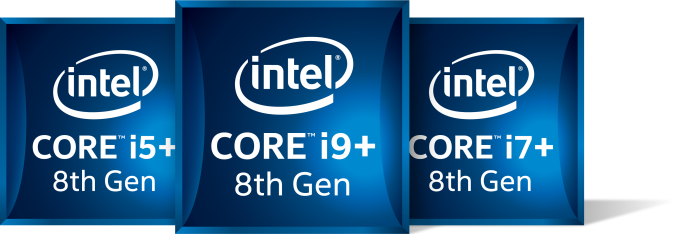Intel Expands 8th Gen Core: Core i9 on Mobile, Iris Plus, Desktop, Chipsets, and vPro
by Ian Cutress on April 3, 2018 3:01 AM ESTNew Optane Branding
Core i9+, Core i7+, Core i5+
One of the items that Intel is keen to promote with this launch is an update to its Intel RST algorithm when dealing with ‘Optane Memory’, Intel’s brand for Optane whereby a small amount of storage is placed in front of a larger drive to act as a fast cache. Up to this point, Intel platforms that supported Optane Memory in this configuration could only do so on the drive that was used to boot into the operating system. While this worked well for low-cost users that relied on a single rotational hard-disk drive of rust for their needs, with most enthusiasts using a fast SSD (SATA or PCIe) as their first drive that loads the OS, putting Optane Memory in front of this as a cache was relatively pointless – any gains would be intangible at best. With the new generation of products, Intel has expanded the capabilities of Optane Memory such that it can act as a cache for a non-OS drive. This means that a user can have a fast SSD boot drive, a large spinning drive for storage, and then place Optane in front of that storage drive to potentially get much better performance from the drive.
The main idea here is that the large rotational drive is where users store games and large files used in content creation, which often have a long loading time. With the right caching algorithm, and a decent sized Optane Memory drive, Intel likes to promote that loading games and loading media for creative purposes are several factors faster than an equivalent system without an Optane Memory drive.
Part of the news around Optane is that Intel is now creating new processor branding for OEMs that have configurations with Optane. The new brands and logos are similar to the standard Core i5/i7 style that we are used to, however the logos are now a dark blue with white text, and exhibit a plus after the Core i5/i7 name.
So just to be clear, this is not a new line of processors. We will not have to suddenly deal with a Core i9+-8950HK being different to the non-plus counterpart. This is purely a branding exercise, and one that only covers the i5 and higher at that. However, to complicate things, this means that specification sheets can (and will) list the processors as Core i5+ and Core i7+ and even vPro models. This makes looking for particular processor versions in search engines a lot more difficult for almost no obvious benefit. I mean sure, Intel wants to promote the use of its Optane drives, but we already have the Optane branding and the Optane logos to do that for us. This ends up being another logo put onto the box.
Ultimately, Intel is still marketing Optane, its high-cost R&D product, with low capacities at low cost systems with relatively little margin. While it might seem like a noble goal, to bring extra caching performance down to the lower cost segment, it could very easily be done with SATA or PCIe M.2 drives using regular NAND flash. A lot of users would like to see high-capacity, high-endurance Optane drives moving more into the mainstream, instead of more attempts at funneling in a product like Optane into caching.













123 Comments
View All Comments
Ratman6161 - Tuesday, April 3, 2018 - link
I know all about that. Last year we bought a round of thin and light laptops where the users were stamping their feet and insisting they needed i7's. At first I tried hard to explain to them that in the 7th gen mobile "U" cpu's there was practically no difference (and definitely no difference they would notice) between an i7U and an i5U. We bought the i5's and they were P.O'd but they wouldn't have been happy no matter what we gave them. I was very sorely tempted to order a set of Intel i7 Inside stickers to put on them - you can actually buy them on Amazon:)Icehawk - Thursday, April 5, 2018 - link
My manager just didn’t understand why I said buying an i7 laptop doesn’t solve our performance problems - we aren’t ordering the 4 core model, not sure why our vendor hasn’t tried to upsell at least. Yes, I want some fries with that dammit.Chaitanya - Tuesday, April 3, 2018 - link
Stupid marketing of i7+ , what's next brainfart from this marketing team?goatfajitas - Tuesday, April 3, 2018 - link
Actually the issues were process related and continued delays on 10nm parts... The marketing is a BS reaction to try and sell more parts and "slap some lipstick on that pig". Most of their customers don't know or care about the differences, they just want the current "i5" or "i7" part and buy it.nukunukoo - Tuesday, April 3, 2018 - link
Here's to hoping for a surprise 6-core, 32GB Macbook Pro this year...damianrobertjones - Tuesday, April 3, 2018 - link
No, no and no. The value of that machine will fall fast once Apple moves to (Add cpu here) in 2020.goatfajitas - Tuesday, April 3, 2018 - link
LOL. Keep dreaming. Apple has a tiny marketshare and their media strong CPU's are not and will not be a match for Intel in real computing space.PeachNCream - Tuesday, April 3, 2018 - link
But there's already a lot of speculation based on a Bloomberg article of a shift starting in 2020 from Intel x86 CPUs to some sort of higher performance ARM processor in order to unify the OS experience across Apple products. Take a look on Google for Kalamata which is the project name. If what looks like leaks are true, there's a change blowing in the wind in Apple's Macintosh product line.Ratman6161 - Tuesday, April 3, 2018 - link
I doubt it will be a good change if you are a die hard Mac person. As things stand today, no ARM chip is going to match Intel for raw computing power. Power consumption, sure but no where close on raw speed. To me it seems almost like they are getting ready to write off their traditional fan base of graphics people.PeachNCream - Tuesday, April 3, 2018 - link
I really don't know what to make of this from a performance and compute perspective (or any other perspective for that matter) as I don't own or use a Mac. If its true that Apple is planning to use in-house ARM processors in only a couple of years, then they've probably already been in development for a while and they will need to compete with x86 hardware if they expect to land sales. At this point, I'm just curious about what will happen and how it might or might not shake up the industry.